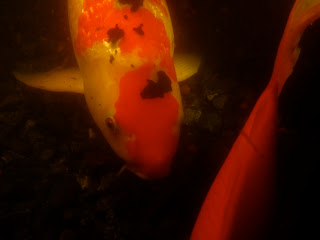So, many of you may not be aware, but the very first aquaponic systems (though they weren't called that) were actually sand-based. Dr. Mark McMurtry did his PhD work on integrating aquaculture and hydroponic growing methods, and after years of research and experimentation, he settled on using sand. The amount of surface area for the bacteria to attach to is orders of magnitude greater than any other growing medium.
So, inspired by that, I've been putting together a small, sand-based system.
I started with the fish tank I made last year (still need to reinstall the liner, which hopefully doesn't have any holes in it (see my notes on this later!)) positioned on the ground under the shade of a magnolia tree. I'll use one of those 4 way spider valves and run one to each grow bed, and two right back into the fish tank at the bottom, to try and flush up any solids. I also plan on having a small aerator in the tank running continuously to keep the fish happy.

I set up a couple of similar, though approximately 1/2 sized boxes up on the wooden deck above as grow beds. I set them up on cinder blocks, so that I could put the 3'X3' Botanicare tray that I bought last year and haven't really had any use for. The tray's purpose is to catch the water coming out of grow beds and any potential sand that might slip through the crack. My thinking was that having a separate water catcher might help to keep the sand out of the fish tank. The grow beds are lined with liners. They are actually two different kinds. One is an EPDM liner that was left over from my pond installation, but is a few years old. The other was one that I bought from Lowe's, and is a kind of mesh-looking thing - something like a glorified tarp that is supposedly fish safe. The orange straps are part of cinch down strap for the top to keep the liner in place as well as help to keep the box's shape and integrity. I ran out of wood, and figured while I was putting this together, the straps would work just fine. The drain pipe right now just goes into the yard while I'm washing the sand. By the way, I put in 4 4X4 with footers under the beams supporting the grow beds to try and keep the deck from falling under the weight.

Here's a look at the grow bed. The pipe at top delivers the water in what I hope will be a somewhat reduced flow rate. I expect that channels will form, and in fact, Dr. McMurtry mentioned that this would happen. The grow beds are tilted slightly to aid in the water flowing to the drain.
A closeup of the inflow system. It's got 1" pipe inside a 3" pipe, both with end caps. The 1" pipe has small holes drilled into the top of the pipe, while the 3" pipe has some slots cut into it on the bottom.
Here you can see the slots.
A view from under the grow beds. I cut a long slit the width of the grow bed to let the water drain out and stuffed the liner through the slit. It's hard to see in the photo above, but maybe if you look at the larger version. Anyway, the extra liner serves as a kind of a water bladder, and then I just cut a hole in it to let the water out. This was the best I could come up with, as I was worried about water choosing it's own path to go if I just cut a slit in the liner without stuffing it through the crack.

Above the crack, I put some fiberglass window screen material to try and keep the sand in. Dr. McMurtry used something similar, and he said that even cloth or clothing would work. That said, in my initial test, I did see some sand wash out. I expect some sand to come out, and I'm hoping it's a function of how fast the water is flowing in. The nice thing about the water catchment is that I can just scoop up the sand and put it back into the grow bed. But, if it starts coming out profusely, I'll be in trouble!
This is what I put into the grow bed. First, two bags of pea gravel, then 3 bags of multi-purpose sand, and then 3 bags of fine grain play sand. Hopefully there aren't any weirdo toxins or anything like that in the sand.
So, here's the rub. After first testing both grow beds for leakage by merely filling it about 1/4 full of water (before I cut open the slit) and finding none, I filled one grow bed with all the gravel and sand and tested again. Uh oh! This time, a leak developed that was pushing water out the bottom of the grow bed. My theory is that there is a small leak in the liner somewhere up along the lowest wall, and that I didn't see it initially, because I didn't fill it with enough water. This is the EPDM liner that is several years old. I kept it folded carefully and away from any sharp objects and the like, so I'm really surprised that it leaks. I sure hope my pond doesn't have a leak somewhere, too!
In addition, in the other grow bed, I found a leak in the bladder on the opposite side from where I was planning to cut the slit to drain the water. This is especially troubling, since I just bought the liner 2 days ago. So, right out of the bag, the liner has a hole in it. This is the mesh-like liner from Lowe's. As a result, I would strongly recommend AGAINST anyone ever buying this product.
So, I'm at a crossroads. Do I continue, knowing full well that I have a leak in one grow bed that's already done with all the sand AND a leak in the other grow bed with a crappy liner? The only way this isn't a show stopper is because of my drain pan. Right now, everything drips into it, even the leaks. But it means that the boxes won't last long (hopefully at least a season).
Or, do I quit now and cut my losses? Perhaps looking into pre-made plastic tubs that would suit my purpose, cost more, but be less likely to leak? Or just do what everyone else does and use hydroton?!
What would you do?
UPDATE 2/7/11: Predictably, I decided to press on! I guess I'm stubborn (stupid) like that. Anyway, I fixed the small leak in the mesh liner box with some fish-safe silicone. The other bed I'm hoping won't leak once I slow the flow down to a reasonable level. I was testing with a garden hose on full blast, and the flow won't be nearly that high.
I'm almost done with the set-up. I need a few more feet of PVC before it's all said and done, and I hope to get to the store this afternoon to finish it up this evening.




















